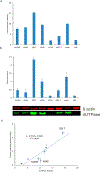ATP-Linked Chimeric Nucleotide as a Specific Luminescence Reporter of Deoxyuridine Triphosphatase
- PMID: 29578692
- PMCID: PMC6484856
- DOI: 10.1021/acs.bioconjchem.8b00124
ATP-Linked Chimeric Nucleotide as a Specific Luminescence Reporter of Deoxyuridine Triphosphatase
Abstract
Nucleotide surveillance enzymes play important roles in human health, by monitoring damaged monomers in the nucleotide pool and deactivating them before they are incorporated into chromosomal DNA or disrupt nucleotide metabolism. In particular, deamination of cytosine, leading to uracil in DNA and in the nucleotide pool, can be deleterious, causing DNA damage. The enzyme deoxyuridine triphosphatase (dUTPase) is currently under study as a therapeutic and prognostic target for cancer. Measuring the activity of this enzyme is important both in basic research and in clinical applications involving this pathway, but current methods are nonselective, detecting pyrophosphate, which is produced by many enzymes. Here we describe the design and synthesis of a dUTPase enzyme-specific chimeric dinucleotide (DUAL) that replaces the pyrophosphate leaving group of the native substrate with ATP, enabling sensitive detection via luciferase luminescence signaling. The DUAL probe functions sensitively and selectively to quantify enzyme activities in vitro and in cell lysates. We further report the first measurements of dUTPase activities in eight different cell lines, which are found to vary by a factor of 7-fold. We expect that the new probe can be of considerable utility in research involving this clinically significant enzyme.
Conflict of interest statement
Notes
The authors declare no competing financial interest.
Figures






Similar articles
-
Measuring deaminated nucleotide surveillance enzyme ITPA activity with an ATP-releasing nucleotide chimera.Nucleic Acids Res. 2017 Nov 16;45(20):11515-11524. doi: 10.1093/nar/gkx774. Nucleic Acids Res. 2017. PMID: 29036687 Free PMC article.
-
A Chimeric ATP-Linked Nucleotide Enables Luminescence Signaling of Damage Surveillance by MTH1, a Cancer Target.J Am Chem Soc. 2016 Jul 27;138(29):9005-8. doi: 10.1021/jacs.6b02895. Epub 2016 Jul 18. J Am Chem Soc. 2016. PMID: 27413803 Free PMC article.
-
The role of dUTPase and uracil-DNA repair in cancer chemotherapy.Curr Protein Pept Sci. 2001 Dec;2(4):361-70. doi: 10.2174/1389203013380991. Curr Protein Pept Sci. 2001. PMID: 12374095 Review.
-
Effects of vaccinia virus uracil DNA glycosylase catalytic site and deoxyuridine triphosphatase deletion mutations individually and together on replication in active and quiescent cells and pathogenesis in mice.Virol J. 2008 Dec 2;5:145. doi: 10.1186/1743-422X-5-145. Virol J. 2008. PMID: 19055736 Free PMC article.
-
Glycine rich P-loop motif in deoxyuridine pyrophosphatase.Curr Protein Pept Sci. 2001 Dec;2(4):301-11. doi: 10.2174/1389203013381017. Curr Protein Pept Sci. 2001. PMID: 12369927 Review.
Cited by
-
Chemical Tools for the Study of DNA Repair.Acc Chem Res. 2022 Dec 6;55(23):3495-3506. doi: 10.1021/acs.accounts.2c00608. Epub 2022 Nov 10. Acc Chem Res. 2022. PMID: 36355579 Free PMC article.
References
-
- Lindahl T (1993) Instability and decay of the primary structure of DNA. Nature 362, 709–715. - PubMed
-
- Brynolf K, Eliasson R, and Reichard P (1978) Formation of Okazaki fragments in polyoma DNA synthesis caused by misincorporation of uracil. Cell 13, 573–580. - PubMed
-
- Andersen S, Heine T, Sneve R, König I, Krokan HE, Epe B, and Nilsen H (2005) Incorporation of dUMP into DNA is a major source of spontaneous DNA damage, while excision of uracil is not required for cytotoxicity of fluoropyrimidines in mouse embryonic fibroblasts. Carcinogenesis 26, 547–555. - PubMed
-
- Friedberg E, Walker G, Siede W, Wood R, Schultz R, and Ellenberger T (1995) DNA Repair and Mutagenesis American Society for Microbiology Press, Washington, DC.
Publication types
MeSH terms
Substances
Grants and funding
LinkOut - more resources
Full Text Sources
Other Literature Sources

